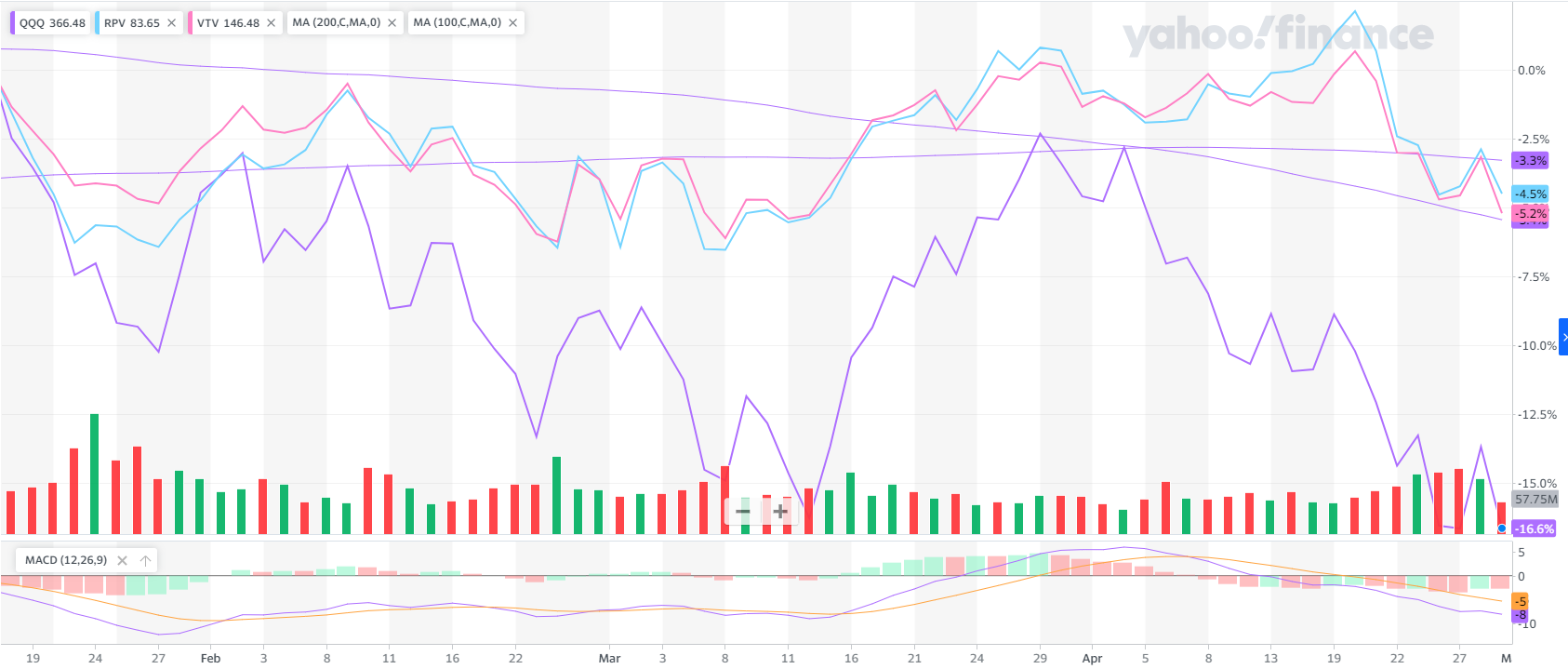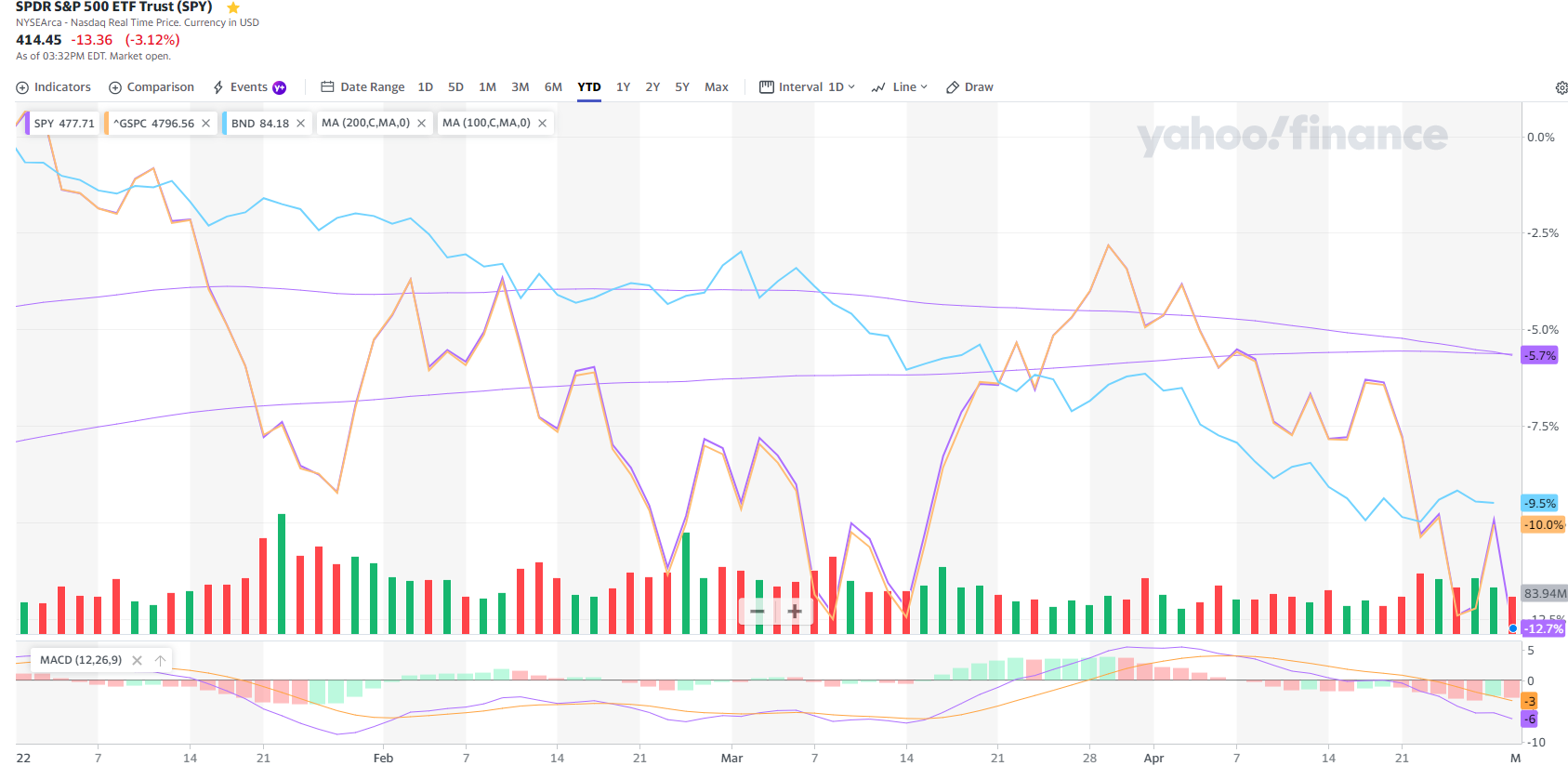After an encouraging first quarter rally which lifted the S&P 500 well off its YTD lows, the start of April ushered in another wave of selling pressure.
April was a treacherous month, dragging the broad indices down to their 2022 low –taking out the March 7th and March 14th double bottom. The S&P 500 shed 8.5%, while the tech heavy NASDAQ 100 (QQQ) declined 13%. Small caps declined 9% and bonds declined another 4% for the month.

WHAT’S DRIVING THE MARKETS
Earnings are having an impact on daily market movements with 220 S&P 500 companies reporting earnings in April. Some cash rich companies posted major earnings beats and provided a sense of relief that strong companies can still grow earnings (Microsoft and Meta, formerly known as Facebook). Meanwhile, some of the largest corporations pointed to continued challenges due to supply bottlenecks, rampant inflation, and slower growth (Apple, Netflix, Amazon, Google).
While most earning-reporting companies (182, or 83% of those reporting) have beaten their consensus estimates, their forward guidance is more deserving of investor attention. Many companies have indicated a cautious outlook, and it is affecting the overall market sentiment, which continues to sour. However, most of the profit growth has not been as bad as expected, which is putting a floor under the market.
Expectations are often about better or worse versus good or bad. Expectations now are quite low, which could be read as a contrarian indicator that the market has only so much more to fall before buyers re-enter the scene. At the end of the day, both expected earnings AND interest rates determine a fair valuation for publicly traded companies, though the two metrics are very interrelated.
This leads to the main driver of the market – the Fed’s interest rate policy, and the expected pace of rate increases. There was talk of a .75% increase at the May policy meeting, which caused a market sell off. A .50% increase is the most likely scenario from the Fed’s rate meeting this week. It may be a matter of the Fed simply “ripping off the band aid” to enable the market to understand that the economy can support higher rates. Case in point – at the Fed’s last meeting where they first increased the Fed Funds rate by the expected .25%, the market rallied. Perhaps after this week’s increase in Fed funds rate the market will do the same.
Another school of thought is that the markets (both equity and bonds) are doing some of the Fed’s job. Treasury yields have increased significantly this year – the 10-year has moved from 1.5% at the beginning of 2022 to 2.9% at the end of April. The S&P 500 has declined 12% YTD. The deteriorating “wealth effect” is slowing down growth and demand, which should help ease the inflationary concerns that are forcing the Fed to raise rates. At some point, demand will cool and supply will stabilize, which may lead to rates eventually cooling off, which would likely then be a tailwind to rising stock prices.
In our opinion, the U.S. economy has earned the right for the Fed to move to a 2.5% funds rate, as earnings continue to grow, consumer demand remains robust (waiting 20 minutes for a $6 Starbucks latte anyone?), the labor market tight, and money cheap. We anticipate the market settling down during the second half of the year after several rate increases are behind us.
PORTFOLIO ADJUSTMENTS
On 2/23 our process recommended reducing exposure to XLG, (S&P top 50), which further reduced our remaining large cap growth position. On 3/2 we then fully evacuated XLG and repositioned to RSP, the S&P equal weigh ETF. RSP equally weighs each of the S&P 500 constituents, thereby providing more exposure to those sectors that represent a smaller percentage of the U.S. market capitalization (energy, utilities, materials, consumer defensive). These sectors are inherently more defensive and inflation resistant than the traditional cap weighted metric of the S&P 500 index which is notably overweight technology. Since 3/2 to 4/29, RSP has declined 3.5% and XLG has declined 5.8% while the S&P declined 4.8%.
Our greatest “win” YTD remains the 1/14 shift from QQQ large growth to RPV/VTV large value. As growth and tech continue to deteriorate, the value complex has help up relatively well, at least until last week, when just about every corner of the market was sold off. Since 1/14, QQQ (purple line) has declined 16.5%, while RPV (blue line) and VTV (pink line) have declined 4.5% and 5.2% respectively. The S&P 500 declined 10.5% during the same period.

Our process is proactively manaing and mitigaing risk in an orderly fashion while the market goes through bouts of fits and starts. Sell offs have been swift, and rallies have been fleeting. At this juncture, staying fully invested, but allocating capital to areas that are holding up better on a relative basis should position us to capitalize when the market bottoms. Of course, should the market deteriorate further, our process will systematically further reduce risk, likely by way of reducing exposure to those same positions that have weathered the sell off better than others. As of the end of April, our TWG model portfolios have declined about 2% less than their respecitve bechmarks YTD after fees, redulting in declines 20% less than their benchmark.
LOOKING AHEAD
With volatility spiking and rates screaming higher, we believe the worst of the adjustment period and price discovery may be coming to a climax. After the Fed raises rates during their next two policy meetings in May and June, and the market particpants realize that the world is not coming to and end, we believe the market can work though a higher rate environemnt, albiet one with slowing growth. Once the Fed does its job to slow down growth, we should see inflation softening up a bit. We believe with the combination of a shift from antipation of higher rates to rates actually being higher, with a likely attendant reduction of inflationary pressures, the market will regain its footing and look to the future. The weight of the evidence would indicate that the U.S. economy is resiliant and strong enough to support continued economic expansion. Like the changing of the seasons from winter to spring, we are hopefully for sunnier days ahead.
